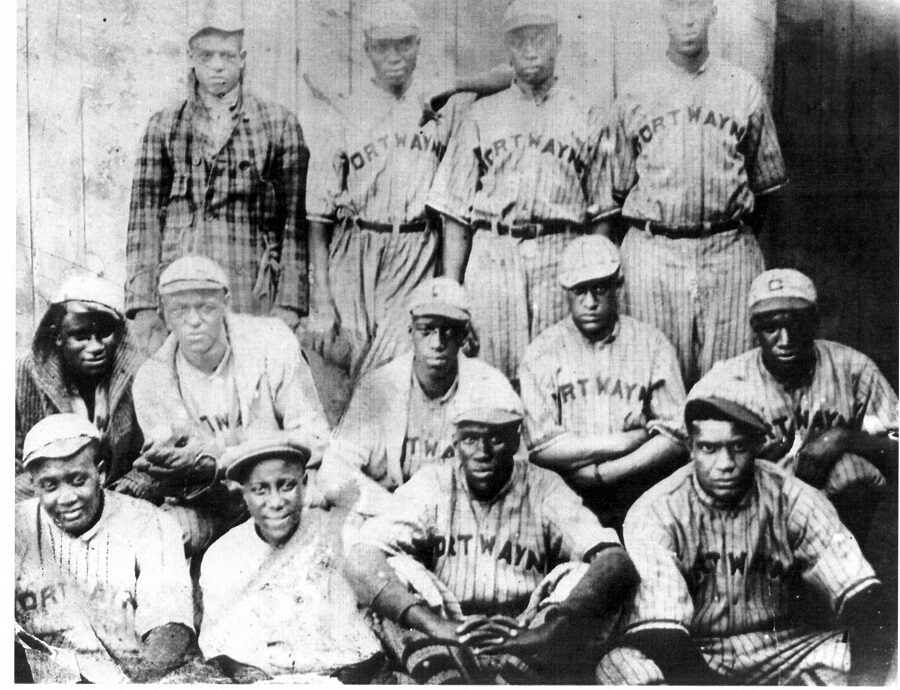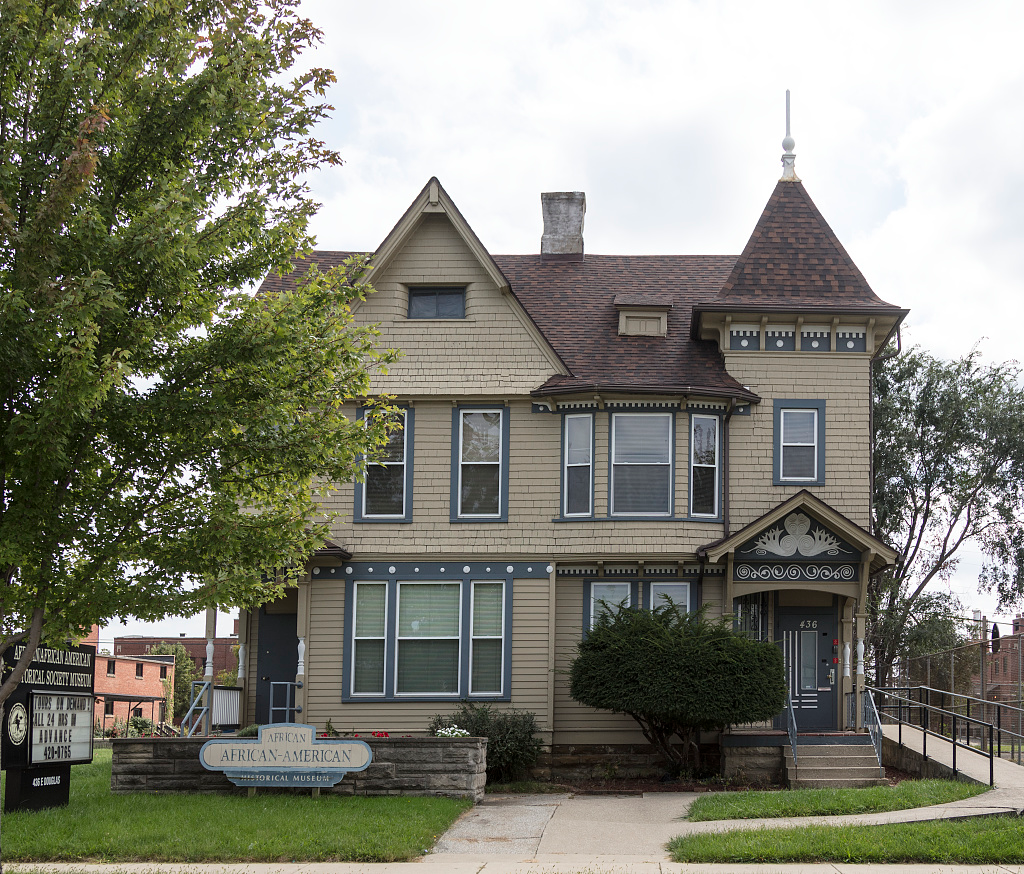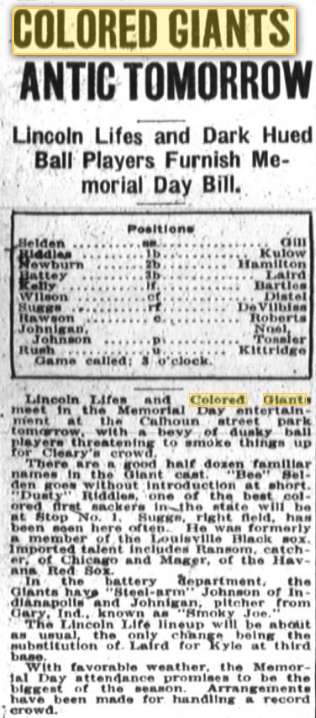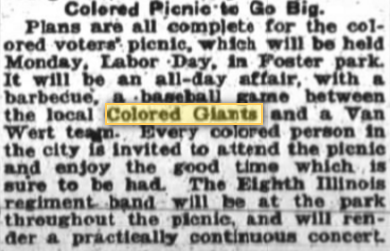
The Fort Wayne Colored Giants was the only black baseball team to represent the city of Fort Wayne for forty-two years, from 1907 to 1949. In that time period, baseball was a segregated team sport, with black athletes playing only on all black teams. The Colored Giants team was one of the premier black teams in northeast Indiana in that period. Other black Fort Wayne teams included the Black Diamonds (1916-1917), Dupee’s All-Nations (1919), Riddle’s All- Stars (1920-1922), the Cadillac Colored Giants (1921-1922), and the Fort Wayne Colored Pirates (1926-30s). Indiana had over thirty-seven traveling black teams, extending from West Baden in the south to South Bend in the north, and Evansville in the west to Fort Wayne in the east.
Young men with outstanding baseball skills comprised the Fort Wayne Colored Giants. These young men developed their baseball prowess playing sandlot, church ball, “pickup” baseball, and community ball. Young men would come play baseball from as far away as Marion and other black communities in northeast Indiana. Fort Wayne newspapers advertised player recruitment and notices for team competitions. It also provided notification of both games and team and league scores.
Cities large and small adopted black baseball teams when they could find players and afford to do so. The teams vitalized and energized their communities, both black and white. The teams were self-sufficient and team members were paid scanty sums. Community teams typically passed a hat around during the game where patrons would contribute whatever they could to help defray costs. Teams struggled to maintain their budgets and keep their key players. Some teams were very wealthy, such as the Pittsburgh Crawfords of the National Negro League. Others just made ends meet and vanished after a season or two. The Fort Wayne Colored Giants did manage to provide a stipend for their players.

Baseball was the cornerstone of many communities, both large and small. This was the heyday for black businesses and the black community. Life revolved about church, neighborhoods, clubs, and organizations like the Phyllis Wheatly House, the former community center, which is now home to the Fort Wayne African African-American Museum.
The Giants’ home field was located in southeast Fort Wayne, where home and exhibition games took place. The team also played at Fort Wayne’s League Park, which was constructed in 1883, and in 1922 renamed Lincoln Life Field. The Fort Wayne Colored Giants played black teams such as the Toledo Mud Hens, the Indianapolis ABCs, the Chicago Giants, Saint Louis Stars, the Evansville White Sox, and Pittsburgh Homestead Grays of the Negro National League. The Giants team played ‘out of local area’ Indiana teams, including those from Lagrange, Decatur, Geneva, Uniondale, Marion, Huntertown, Evansville, La Otto, Ligonier, Hudson and North Manchester. They also played teams from Hicksville, Antwerp, Convoy, and Van Wert, Ohio.
The Colored Giants had standing rivalries with area white teams, such as the Fort Wayne Lincoln Lifers, the Columbia City Grays, the Roanoke Independents, the New Haven Visible Pumps, the Kendallville Reds, the Garrett K of Cs, and the Auburn Athletics.

The Colored Giants team had multiple owners and managers over the years and these include: (1909) Mr. Harry Ellis, both owner and manager; (1916) Mr. L.B. Dupee, owner and Mr. George Wilson, manager; (1919) Mr. Bob Jones bought out Mr. L.B. Dupee and retained Mr. George Wilson as manager; (1920-1921) Mr. Bob Jones, owner and Mr. Johnson, manager; (1921- 1922) Mr. Bob Jones, owner and Mr. T.E. Lewis, manager; (1923-192) Mr. Moses Taylor, owner manager; and (1930-1949) no information on owners or managers was available. The information presented was obtained from Fort Wayne newspaper articles of the period.
Very little is known about the team’s owners and managers, but the Fort Wayne Journal Gazette Newspaper did feature one. That was Moses Taylor, the longest serving owner and manager of the Colored Giants (1923 to 1929). The story of black baseball in Fort Wayne is a story of a family involved in the community and in baseball. It is a story of a man, a visionary and an entrepreneur, who became the catalyst for the creation of a strong baseball team. His dream generated passion within a community and among a group of young black men. He set the stage for solid baseball play with major teams, both semi pro and local.
After a team bus broke down in 1929 in Pittsburgh, Mr. Taylor stayed and found a job. He moved the rest of his family to Pittsburgh around 1930. Mr. Taylor utilized his experience with the Fort Wayne Colored Giants to form the Pittsburgh Mystics, as reported by his daughter Mrs. Lucille Taylor Wooden of Cleveland, Ohio. This team played against the Pittsburgh Homestead Grays of the National Negro League.

The Fort Wayne Colored Giants infused and energized the black community of Fort Wayne. The team established its mark in the city and in baseball. The Fort Wayne Tincaps are the legacy of the Fort Wayne Colored Giants and the many white league teams of the era. They all contributed to baseball history in Fort Wayne. The Giants are one of the few Fort Wayne baseball teams, black or white, from that era (1907-1949) to be recognized in the 21st century via news media and with a plaque at Parkview Field. They assume their proper place in the history of Fort Wayne as true contributors to the development of sports history in the Summit City.
